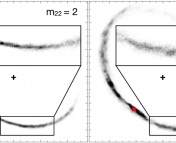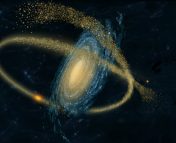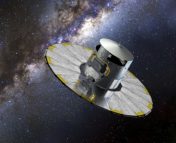Title: Probing the Nature of Dark Matter Particles with Stellar Streams
Authors: Nilanjan Banik, Gianfranco Bertone, Jo Bovy, Nassim Bozorgnia
First Author’s Institution: GRAPPA Institute, University of Amsterdam
Status: Submitted to JCAP (open access)
The type of matter that makes up humans, the Earth, and all of the stars in the Universe is only a fraction of the matter that exists. The rest is made up of a mysterious dark matter that light passes straight through, leaving it invisible. Although we cannot see this dark matter, we know that it exists because of the effect that it has on things that we can see. For example, just like the wind reveals its presence by blowing the leaves on trees, dark matter gives itself away by its gravitational pull on stars and galaxies. Today’s paper explores how we might use future telescopes to study this gravitational pull on stellar systems to describe the dark matter in our Universe.
One type of astronomical system that is particularly susceptible to the effects of dark matter is stellar streams (Figure 1). Stellar streams and their interactions with clumps of dark matter have been previously discussed in this astrobite. Today’s piece delves deeper into this discussion.

Figure 1. An illustration of a stellar stream, the remnant of a satellite galaxy, wrapped around a larger galaxy like the Milky Way. (Source: Jon Lomberg.)
The general picture is that our galaxy is surrounded by streams of stars – the remnants of smaller galaxies that have been torn apart by the gravitational force of the Milky Way. The galaxy is also surrounded by small clumps of dark matter, whose number and size depend on properties like the mass and temperature of the dark matter particle itself (Figure 2). As these small clumps of dark matter orbit around the Milky Way, they can punch holes through stellar streams, gravitationally pulling away the stars and leaving behind gaps.
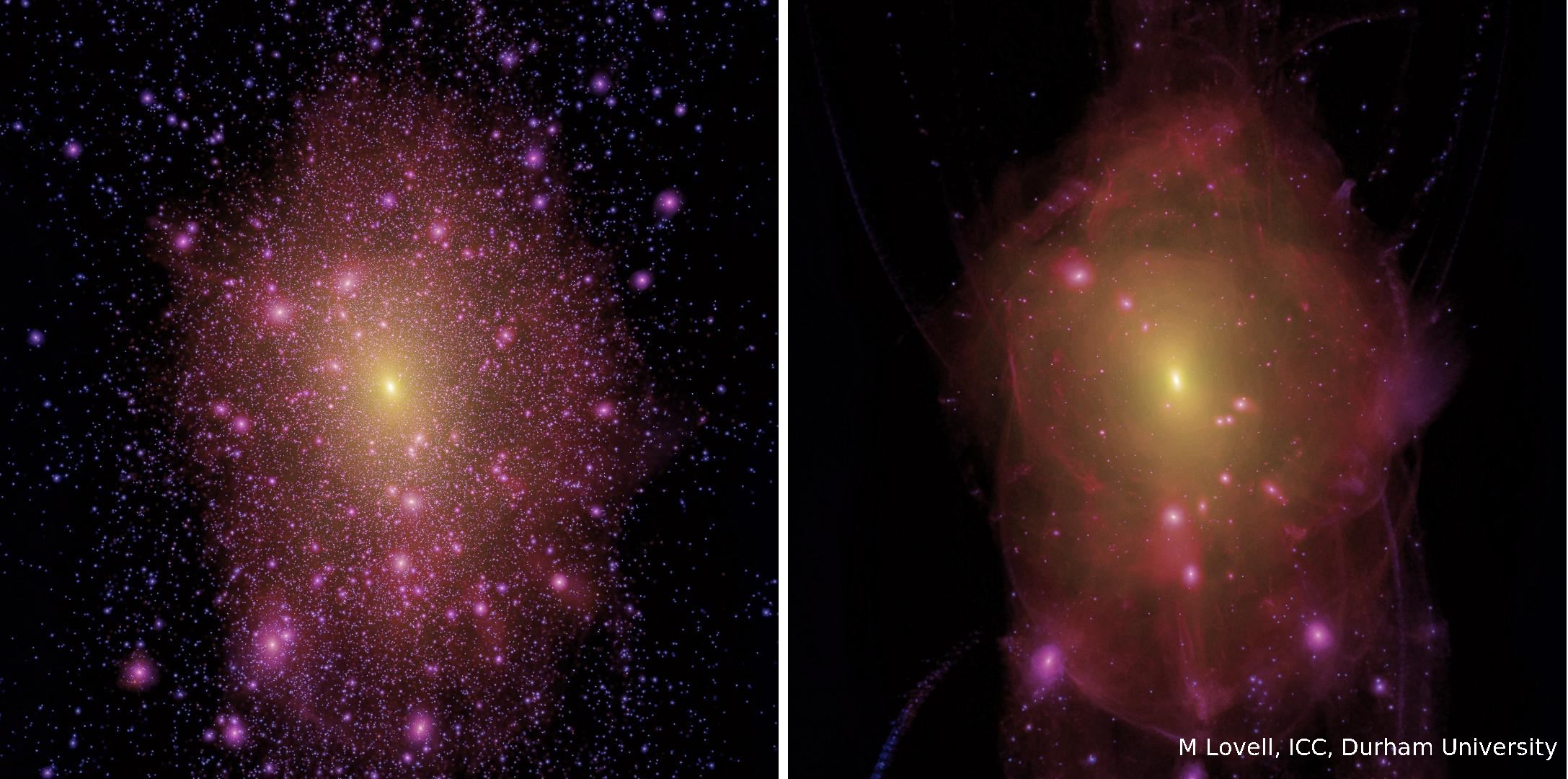
Figure 2. Simulations of a galaxy with heavy cold dark matter (left) and light warm dark matter (right). Brighter points have a higher density of dark matter. The cold dark matter model predicts many more clumps of dark matter, extending down to smaller sizes, than the warm dark matter model. (Source: Aquarius/Virgo/ICC Durham University.)
The authors of today’s paper make theoretical predictions for the density of stars along a stellar stream for different dark matter models and ask whether we will be able to distinguish between these models with the next generation of telescopes.
First, they consider the expected number of dark matter clumps within the Milky Way for different dark matter models. In particular, they are interested in the difference between heavy cold dark matter and light warm dark matter. Based on powerful numerical simulations, Figure 3 shows the expected number of dark matter clumps at a given mass that lie within the orbit of a typical stellar stream. Models with heavier dark matter particles predict more clumps of dark matter, particularly at the smallest masses. This means that in general, heavier dark matter particles should produce more gaps in streams and, more specifically, more small gaps caused by the smallest clumps.
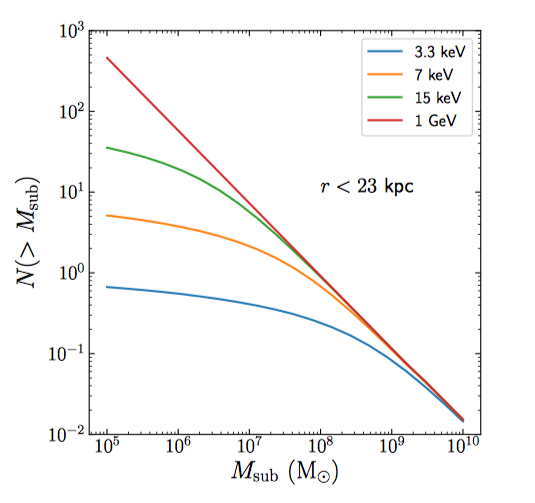
Figure 3. The predicted number of dark matter clumps of varying mass for different dark matter models. The x-axis is mass, and the y-axis is number of clumps with mass greater than M. The heaviest dark matter models (red) predict many more dark matter clumps, especially at the lowest masses. In this paper they compared heavy 1 GeV dark matter (red) to light 3.3 keV dark matter (blue). (Source: Figure 1 in the paper.)
The authors use this information to predict the number of collisions with dark matter clumps of various masses over the lifetime of a stellar stream. They find that for the lowest mass dark matter particles a typical stream has only a couple collisions. However, for the heaviest particles the stream would collide with more like 50 clumps. They then simulate this process with the expected number of collisions to see the final density of stars along the stream.
Figure 4 shows the expected density resulting from these simulations. They find that heavy cold dark matter does indeed produce more small gaps. Interestingly, they also see that a larger number of collisions does not just lead to more gaps, but pushes the stars toward the center of the stream (to the right of these plots). This means that instead of simply looking for individual gaps caused by single collisions, perhaps the best way to study the effect of dark matter clumps is by looking at the variations in density along the entire stream.

Figure 4. Density variations along stellar streams caused by collisions with dark matter clumps. The x-axis shows the length along the stream, and the y-axis shows the ratio between the density of a stream that has collided with dark matter clumps and one that has not. This means that if there were zero dark matter clumps, the density would be equal to 1. The left panel shows the expected variations for light warm dark matter. The right panel shows heavy cold dark matter. Each line is an individual simulation of a stellar stream and the red line is the example they use to make predictions for LSST. The heavy cold dark matter model predicts more, smaller clumps. The streams on the right therefore have more, smaller gaps, and have a buildup of stars towards the center of the stream (righthand edge of the plot). (Source: Figure 3 in the paper.)
The next step is to determine whether upcoming telescopes will be able to detect this difference in density. In particular, the Large Synoptic Survey Telescope (LSST) will be a powerful tool for studying stellar streams – it will observe a large fraction of the sky over 10 years and will be able to see much fainter objects than its predecessors. The authors use this information about the faintness limit of LSST to determine how well it will be able to observe the density along a typical stellar stream, and how well we will be able to use this data to distinguish between dark matter models.
They find that LSST should allow us to distinguish between warm and cold dark matter and to definitively rule out certain models! This is an exciting prediction – these invisible clumps of dark matter have long been predicted, but remain undetected. With their detection we will be able to settle long-standing questions about whether our galaxy really does match the predictions of the standard cold dark matter model. Of course, real data is always more complex than theoretical predictions, and powerful new telescopes like LSST always bring new and unexpected challenges. When LSST sees first light in a few years it will be exciting to see how much we can learn about stellar streams and the nature of dark matter!

